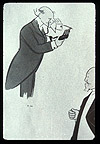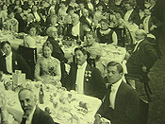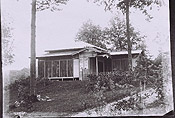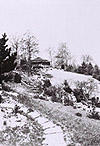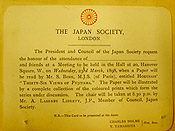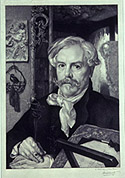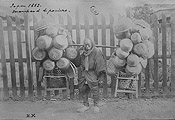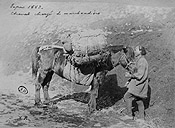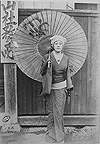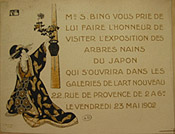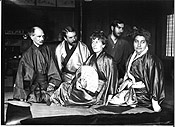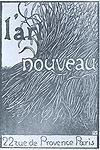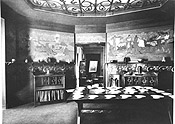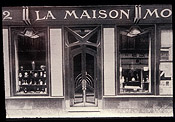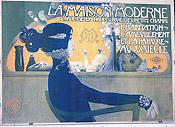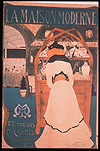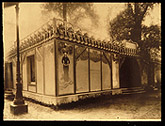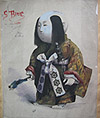The browser will either open the file, download it, or display a dialog.
|
|
Lost and Found: S. Bing's Merchandising of Japonisme and Art Nouveau |
||||||||||
|
From the moment of S. Bing's death, in September 1905, a curtain of obscurity fell on what was known until a renewed interest in art nouveau in the nineteen sixties brought the name Bing back into prominence. Well-known as a progressive dealer, Bing (fig. 1) always kept the personal side of his existence hidden and out of reach from the public record. Those few individuals who got to know him at all—often colleagues from the art world in Germany such as Justus Brinckmann (1843-1915), the Director of the Kunst und Gewerbe Museum in Hamburg—met with the dealer in the secure confines of his private apartment on the rue Vézelay, near the Musée Camondo in Paris. Here, in a world filled with innumerable Japanese objects, Bing entertained his guests. Whether they were fashionable, creative artists such as Henry van de Velde (1863-1957), Henri Vever (1854-1942), and others, or his German museum colleagues, Bing's superb collection of Japanese objects (among many other pieces), and a huge number of prints, never failed to amaze them. Raymond Koechlin (1860-1931)—professor at the École des Sciences Politiques—forty years after the fact in 1930, recalled how he became a convert to Japanese art and how Bing cultivated his and others' passion for Japanese prints. Koechlin wrote that Bing opened his home "with the most amicable good will. A small group gathered around him that he invited for dinner parties in the privacy of his home. Gaston Migeon was part of the group,…also Alphonse Isaac, the engraver,…Hugues Krafft, who had come back from the Far East; and always Vever and Gillot; I never missed one of these evenings, to which Bing's son, the young Marcel Bing who was still in college was admitted, and whose intelligence and charm we already knew how to appreciate."1 His collection added to his reputation as a person of exquisite taste. He was recognized as a great aesthete whose demeanor reflected elegance, erudition, and an ability to convey the importance of passion for collecting what was beautiful; in this, he was definitively a person of the "old school" whose pursuit of beauty remained uppermost in his mind. Julius Meier-Graefe (1867-1935), who was to become one of Bing's closest friends, commented in 1933, "Everyone thought of the dainty figure (Bing) with the intellectual head as a Parisian. He spoke and wrote a classic French, avoided all flowery phrases of the boulevard, had the polite manner of a marquis of the old days who spent his leisure chasing bon mots and who liked to spend time in his library. One would hardly have credited him with the exceptional energy of a researcher, least of all that of a dealer. Bing was both. A substantial part of the beginning of the intellectual conquest of Japan is due to him."2 Bing could mesmerize collectors; he was a suave and persuasive businessman, who recognized that in order to function successfully during the crisis precipitated by the Dreyfus affair, it was necessary to remove himself from the public eye as much as possible. Always discreet, Bing was quite obsessive about his decision to conceal his identity; only a few people knew of his private collections, and even fewer knew anything about his personal life. To him it was the artwork that he championed —whether Japanese or, later, his version of an art nouveau—that was foremost; his own ego, and life, had to be sublimated, even eliminated. | ||||||||||
| There is no doubt now that Bing will always remain somewhat of a mystery; even after forty years of pursuing leads about his life, we know very little about his daily existence. Little has been found that would shed light on his family life. While a few details have been located on his business practices and dealings, there are no definitive archives dedicated to his trade negotiations; only scant letters housed in the archives of the various museums Bing dealt with speak about his art dealing. Were the times he lived in responsible for such secrecy? Were the ensuing French and world events after Bing's death what led to a purging of the record of his life and business? Or, more significantly, even after all these years of in-depth research, have we simply not looked in all the right places, examined all the appropriate business and museum archives, that would provide a clearer picture of what Bing did and how he was able to do it? While there is no blue-print available that would allow us to get a firmer grip on Bing's life, clues leading to a more complex picture of the man, and the ways in which he promoted his ideas and activities during his life, do appear—often in the most unusual locations. We must examine some of them today, in order to find what has been lost, and recover Bing's life as one of the primary art patrons of the nineteenth century. In the process we might gain a clearer picture of the ways in which he marketed art and became the primary figure in the art nouveau movement. It will appear that Bing was a brilliant tactician who knew how to be a successful businessman by anticipating market fluctuations—the rise and fall of fashion—in order to survive in his chosen areas of emphasis. It is also clear that by knowing so many people in the art world, and by sustaining these ties for decades, Bing was able to set up a detailed network of personal associations, thus allowing him to expand his business more easily. | |||||||||||
| MARKETING JAPAN AND JAPONISME While the ways in which Bing promoted the taste for Japanese art—both on the most popular level and on the highest levels of taste—are charted in the exhibition that prompted the symposium leading to this publication, the most recent investigations have looked into uncharted aspects of Bing's working methods. We know of Bing's involvement in the sale of Japanese art throughout the European continent and in the United States during the 1880s. However, new information has come to light that illuminates how Bing's ties with England were extensively enlarged by March, 1892.3 In that month, Bing became a member of the Japan Society in London, a group dedicated to the popularization of Japonisme (fig. 2) and the study of Japanese art on the highest levels. Bing was elected in the company of two of his closest colleagues at the time: Charles Gillot (1853-1903), who had worked with Bing in the production of his revolutionary magazine Artistic Japan, and Hugues Krafft (1853-1935), a photographer and traveler to Japan (1882-83), whose home outside Paris—Midori-no-sato—often served as a convenient meeting place for a circle of erudite collectors of Japanese art, including Bing (figs. 3, 4).4 Membership in this elite group is significant; it underlines Bing's role in the sponsorship of Japan in England and reiterates his importance as a dealer and power-broker who worked to sponsor other individuals as members in the special society. As a member of the group Bing, had two obligations to fulfill. First, it was necessary for any new member to give a lecture of his own choosing on Japanese art to the membership of the organization (fig. 5) and, second, to recruit new members thereby adding to the group's prestige internationally. It is to both these aspects that we must now turn. |
|||||||||||
| As a friend and colleague of many of the primary Japonistes in France, and a member by December 20, 1892, Bing proposed a large number of individuals as Corresponding Members.5 These included Alexis Rouart (1839-1911), the younger brother of Henri Rouart—the collector of the Impressionists and especially Degas—and an individual who had become a fervent connoisseur of Japanese art, especially ukiyo-e prints, and Henri Vever, a leading jeweler and another significant collector of Japanese art, especially ukiyo-e prints. Over time, Vever amassed a superb collection of Japanese prints, some of which were of the highest aesthetic quality. The fact that Bing supported both of these men for membership attests to his close relationship with them and his knowledge of what their personal collections contained, much of which could have been secured with his assistance.6 Ever mindful of the importance of getting the message out about the diversity of Japanese art through elegant publications, Bing also supported the membership of Maurice Joyant (1864–1930) of Boussod, Valadon & Co., and Michel Manzi (1849–1915), an engraver who became technical director of the engraving atelier at Boussod, Valadon & Co. and who, in 1897 with Jean Boussod (1865-1891) and Joyant, took charge of the publishing division of the company, which then became known as Jean Boussod, Manzi, Joyant & Co. Manzi's collection of surimonos (limited edited prints) and Japanese prints was well known.7 By having these members accepted, Bing saw to it that the ranks of the Japan Society were augmented with key figures from France, especially those individuals, similar to himself, who had been amassing collections of Japanese art of significant value. Since all of these men knew one another, and were becoming increasingly familiar with Japonistes in London, this was a very effective way for contacts and ties between collectors to be strengthened and explicitly enlarged. But Bing did not stop with this initial group of nominees. | |||||||||||
| By March 1893, Bing saw other individuals he had proposed for membership elected into the Japan Society. These included Luigi Chialiva (1842-1914), a Swiss painter who worked in the Barbizon landscape style, and Edmond Michotte (1830–1913), a musical composer and an occasional art dealer from Brussels.8 | |||||||||||
| Bing's relationship with Michotte is also worthy of further discussion. Apparently Bing and Michotte formed an extremely close business relationship, which lead Michotte to secure most of his Japanese art objects through Bing. Acting sometimes as Bing's agent in Brussels, and as someone who actively promoted Japanese art in Belgium, Michotte formed a collection of thousands of Japanese objects of all types. Many of these, which he later sold to the Belgian government, served as the basis for the Musée Michotte; at the time an oft-maligned collection that actually contained many objects—especially Japanese prints—of exceptional quality.9 Although it would take us too far afield to write a detailed history of the ties between Bing and Michotte, the existence of letters from Michotte to the curatorial staff of Belgian museums gives us an idea of the extent of the relationship between Bing and Michotte.10 | |||||||||||
|
Bing proposed for membership two other figures who were closely linked with him. The first was Edmond de Goncourt, (fig. 6) who, by the early 1890s, was a famous novelist who saw himself as the primary proponent of Japonisme in France.11 While Bing would later have an angry debate with Goncourt over the publication of a book on Hokusai,12 in 1893 both men, in spite of their differences, must have recognized the other's importance to the Japonisme movement. From the beginning of Bing's activities as a dealer, Goncourt had been a regular visitor to his shops, and an avid buyer of Japanese objects and promoter of Japonisme. It is because he recognized Goncourt's fame as a writer with a long-standing commitment to Japonisme that Bing thought he would be a good inductee for the Society.13 More significantly for an understanding of the ways in which the taste for things Japanese influenced the emergence of Art Nouveau, Bing also proposed P. A. Isaac-Dathis for the Japan Society.14 Isaac, at the moment of his nomination, was not only involved in collecting Japanese art, but he was taking the lead in seeing that Japanese design elements were included in his own studies for the decorative arts, especially textiles. By 1895, when Bing shifted his activities toward the exhibition and making of craft objects for the home, Isaac, whom Bing called a friend became increasingly important to Bing's venture into art nouveau.15 He contributed floral-motif hanging textiles to Bing's shop (fig. 7), arranged in a manner suggestive of an appreciation of Japanese models—either prints or screens. Isaac was, therefore, in the forefront of those designers whom Bing encouraged to study Japanese art, with the hope that they would apply Far Eastern motifs and design principles to their own work. | ||||||||||
|
Bing's other obligation toward the Japan Society was to deliver a public lecture to the group, in English, and in London. Given Bing's extensive travel commitments to the United States in 1894, and his opening of the Salons of Art Nouveau in 1895-96, Bing postponed his lecture until March 23, 1898.16 By this time, Bing's reputation as a learned Japoniste had spread. The lecture he prepared on "The Thirty-Six Views of the Fuji-Yama" by Hokusai, then one of the most esteemed of the ukiyo-e printmakers, seemed quite appropriate. His selection of a very popular print series, one well known not only to the members, demonstrated that Bing was interested in appealing to the broadest public audience. There was only one problem: Bing, ever true to his practice of remaining in the shadows, or perhaps because he couldn't speak English well enough or, more importantly, was too involved with the creation of his art nouveau ateliers, did not come to London to present the paper. Charles Holme, the Secretary of the Japan Society, read the lecture on Bing's behalf. That no photographs of S. Bing, as of yet, have been found in the Society Archives—although members were obligated to provide this type of personal documentation—suggests that Bing wanted no publicity for himself at all, and preferred remaining in the background while still working to further the goals of the Society. Indeed, a section in the Japan Society minutes reports that Bing was given the responsibility of collecting annual dues from foreign members of the group; presumably an important task in helping the organization to grow. With Bing's connections throughout Europe this also reflected a wise decision by The Japan Society.17 |
|||||||||||
|
Bing's ability to carefully network with the most significant Japonistes, some of whom were to become not only Bing's clients but sponsors of art nouveau, also led him to establish ties with Hugues Krafft. As an inveterate traveler throughout the world, Krafft had gone to Japan in the early 1880s. While there, he not only collected artifacts and made many watercolors of his trip, but he took extraordinary photographs of Japanese sites and buildings, and of the common people going about their daily activities (figs. 8, 9, 10). These photographic studies, rare for the period, expanded an awareness of Japan among French Japonistes.18 In addition to objects brought back from Japan, Krafft further developed his collection with those he secured from Bing's shop. Krafft also did much more than collect objects. He purchased an actual Japanese home and had Japanese craftsmen, whom he brought back from Japan, install it just outside Paris, where he could live and dress in the Japanese style. Midori-no-sato, as it was called, was situated amidst a carefully designed garden, in the Japanese style, replete with bonsai trees that Krafft purchased from an exhibition that had been held at Bing's shop (fig. 11) in 1903.19 Krafft's home became a place of exquisite refuge; it was here that he escaped from the pressures of the materialistic world around him. It was also here that Krafft held elaborate dinner parties, often for officials from the Japanese Legation in France, or, eventually, members of the French version of the Japan Society in London.20 It was here, as well, that S. Bing came in 1899 to one of the Krafft gatherings. He is photographed, which was extremely unusual for him, in the company of other Japonistes including his friend, the author and collector, Louis Gonse and his wife and Madame Roujon, the wife of Henri Roujon, then Director des Beaux-Arts. All the participants to the gathering, including Bing, are wearing kimonos, attesting to the seriousness of their dedication to Japanese culture (fig. 12). This photograph is the only one found until now that records how Bing looked at the moment when he was readying the Art Nouveau Pavilion for the 1900 Paris World's Fair. Since the Société Franco-Japonaise was officially formed in 1900, one wonders whether the meetings at Midori-no-sato were not held to formalize the French Society itself, a group that helped promote Japonisme and Japanese art into the twentieth century.21 Bing's ties with Krafft suggests many new areas for further investigation; this friendship demonstrates the complexity of his liaisons with private individuals and his ability, even during the late 1890s when he had become the chief patron of art nouveau, to maintain his ties and interests in Japanese art. It was simply good business to do so; it was also one way in which he could reiterate just how significant Japanese art continued to be for art nouveau and the advancement of designs for interiors by 1900. The relationships that Bing had developed also became the foundation for many of his business associations under the new banner of art nouveau. In fact, many of the men who were fervent Japonistes became devotees of Bing's new passion—that of revealing how Japanese art could effectively influence and shape French design. Even Henri Roujon, the Director des Beaux-Arts, was a member of the circle of Japonistes who met at Midori-no-sato; it was he who had asked Bing to travel to the United States, and to report to him on the condition of the applied arts in that country.22 |
|||||||||||
| MARKETING ART NOUVEAU At the same time that he was advocating Japonisme, Bing, under the advice of close colleagues such as the writer and theoretician Julius Meier-Graefe, Justus Brinkmann from Hamburg, and the designer Henry van de Velde, decided to fulfill a dream: to modernize the interior of the contemporary home in order to make it both practical and aesthetically pleasing. Inspired by what he had absorbed from Japanese art, and determined to see that creative work was produced for home interiors, Bing used all the advertising and marketing devices at his disposal, including those he had applied to his Japanese art business, in order to reach a wide public thus primed to understand and, he hoped, buy the latest designed objects for sale in his gallery. What is significant about Bing's new endeavor is the role played by Meier-Graefe, as artistic advisor. This collaboration between the dealer and art patron Bing, and the writer-theoretician Meier-Graefe has not been sufficiently examined and needs further study. As one of Bing's close contacts in the contemporary art world, albeit a figure from a younger generation, Meier-Graefe's ideas about modern design helped Bing define his own vision of the modern home. Thus, Bing's trip to Brussels in 1893, to meet with van de Velde in the company of Meier-Graefe, becomes increasingly valuable to our understanding of the inception of Bing's Art Nouveau gallery. One must ask, however, why has this meeting not received more attention than it has.23 Once Meier-Graefe moved to Paris, after being dismissed as editor of the German magazine Pan in the mid1890s,24 it was possible for the Hungarian-born critic to be on the scene and become a witness to what we now call "design reform." As a critic, and as a witness, Meier-Graefe acted as an interpreter of new art; for the first Salon of Art Nouveau, in 1896, he published no less than three articles in the magazine Das Atelier on what he saw in Bing's gallery.25 These are the most insightful, first person witness reviews written on what Bing attempted. We shall examine them within the context of the discussion that follows, especially since they demonstrate how Bing's closest colleagues further influenced his ideas. |
|||||||||||
| There is little doubt that Meier-Graefe's presence in Paris, from the opening of the first Salon of Art Nouveau, and probably earlier, helped Bing crystallize his ideas on what might be successful, and probably prompted Bing to move more heavily into certain promotional areas. While it is unclear whether Meier-Graefe helped Bing select the artists he showed in 1895, the fact that he had Bing's attention was significant. As he had in promoting Japonisme, Bing now took out advertisements in both daily publications and the more elite art journals, and in the fall of 1895, by means of these advertisements, Bing called on artists throughout Europe to submit works to his gallery for his first Salon of art nouveau. He asked the Belgian artist Georges Lemmen to create a print for which Bing provided a text that clarified what his aesthetic goals were. The text read as follows: "L'Art Nouveau will strive to eliminate what is ugly and pretentious in all things that presently surround us in order to bring perfect taste, charm, and natural beauty to the least important utilitarian objects."26 | |||||||||||
| Bing's interest in internationalism meshed with that of Meier-Graefe. For his Salon opening Bing had Lemmen design his invitations utilizing the most modern lettering and he saw to it that his stationary was modified along the same innovative lines, incorporating a shop logo—a modern concept that Bing championed—as a means by which his emporium could be quickly identified by anyone receiving a letter, an invitation, or a bill. His awareness of the innovations in the print world, especially changes in color lithography, also led him to commission a poster from the Swiss artist Félix Vallotton, which Bing hoped would function as an emblem for his gallery, although we don't know how many posters were printed, or how widely it was visible throughout Paris. Vallotton's poster, while referencing an all encompassing interest in nature, especially plant forms, as the backbone of art nouveau imagery, was not as visually challenging as one might have expected in an era when women as icons of seduction were already used to advertise all kinds of products. | |||||||||||
|
Bing, in 1895-96, did not yet understand that women would become the primary supporters of new design for the home, and thus had Vallotton utilize nature, the more traditional influence, with Japanese art, on art nouveau. Alongside the poster, Vallotton designed a more effective advertising tool—a business card—which on one side employed the same visual device of moving grass (along with the name of art nouveau), while on the back of the card were itemized all types of objects sold in Bing's shop (fig. 13). The designs of the poster and of the card suggest that Bing, as had been the case with his promotion of Japanese art, wanted to do things subtly; only in this way could he continue to maintain the highest aesthetic goals appropriate to his business enterprise and to his well-established reputation.27 | ||||||||||
|
These modifications were also extended to the exterior and interior of his shop; he left nothing to chance in giving his building, and his firm, a makeover. However, since time and costs were important considerations he economized by not using the designs proposed by the already well-known Belgian architect, Victor Horta, for the façade—relying instead on cheaper and more practical means to achieve a similar goal.28 |
|||||||||||
|
Meier-Graefe who wrote on the first Salon in Das Atelier, commented on the various innovations of the installation, especially the importance of the room interiors. He moved away from individual art objects to focus on the types of room interiors that Bing had commissioned from Belgian designers. His interest in van de Velde's efforts led Meier-Graefe to underscore the impact of the dining room and the smaller rooms positioned at either side. To the critic, the "smoking room has much more daring; here the eye is supposed to be stimulated after the meal, therefore bolder designs are used." He went on to note, "van de Velde and his co-worker Lemmen have shown that they can also deploy refined luxury without hurting the basic principle... However, Meier–Graefe believed that the effect was not comforting and criticized the furniture for being "too heavy." In this very perceptive analysis, both sincere and informed, Meier-Graefe noted that he "missed a natural harmony that should exist between the furniture and the room." To him, the best room was that of the cabinet of a collector. "Here everything is light and fresh. The wallpaper is done by van de Velde, a pattern of distinguished taste, on a faintly yellow background where there are very discreet flower designs of the same color…With the furniture of this room van de Velde has created a masterpiece…the material of the furniture is stained light pinewood, the forms could not be simpler, and yet it is distinguished by a really overwhelming gracefulness."29 While this room was sensitively discussed (fig. 14), and achieved the effect of perfect harmony—what Meier-Graefe was looking for—photographs of this small room, and almost all the pieces of furniture (except for one piece) have not been located. Thus, we must rely on Meier-Graefe's commentary to demonstrate why this room was significant. |
||||||||||
| Despite the fact that Bing was attacked in numerous reviews in 1895, he did not take the bait and counterattack in the press. He remained true to his nature; humility was appropriate to his character. He also continued to devise new ways to get his messages out: that all the arts were equal, that France had to look at international artists for inspiration, and that Japan was an all encompassing influence for all types of art work. In the case of the latter, he also found that he had a fervent champion in Meier-Graefe, who reiterated that Japan had strongly influenced all the crafts, not the least being ceramics.30 | |||||||||||
| In the first Salon of Art Nouveau, Bing also gave considerable place to the glass of Louis Comfort Tiffany. When Meier-Graefe reviewed the show, he wrote that Tiffany's works had surpassed the Japanese: "Here, Japan is for the first time defeated, all of its potteries– do not have in the slightest way this wonderful, clear magic of color…here color comes forth purely and with the greatest boldness."31 With this commentary Meier-Graefe demonstrated that he was clearly aware of fundamental issues relating to the decorative arts. He helped elevate American glass to a high position and strengthened Bing's role as a discerning patron of the arts. He also continued to draw parallels between western design and the ways in which these objects were compared with Japan. | |||||||||||
| By early 1898, Bing was seriously considering the formation of his own design ateliers or studios.32 The studios of Louis Comfort Tiffany, or those of others working in Europe, inspired Bing to use his own designers to achieve his goals. Bing wanted to move away from the role of dealer and promoter of works created by artists from various countries, and various artistic persuasions, in order to arrive at a unified vision that would conform to his own ideas about modern design for the home. Discussions with Meier-Graefe—who was also moving toward establishing his own workshops for designers—and van de Velde, undoubtedly helped Bing crystallize this point of view. He launched his own ateliers late in 1898. At first he supervised the creation of small objects—essentially pieces that could be worn or which would provide accents in existing room interiors.33 By 1899, at the time of the Grafton Galleries exhibition in London, Bing not only demonstrated a willingness to show all types of paintings and sculpture, but he was eager to promote the glass of Louis Comfort Tiffany and jewelry produced in his own design studios.34 Because his name was already well-known in artistic circles in London through his marketing of Japanese art, Bing was obviously hopeful that there would be a carry-over effect into his new efforts on behalf of modern design. However, this was not to be the case. The Grafton show was attacked in the press; Bing was mortified to learn that England was unwilling to accept art nouveau and remained as closed-minded as the French had been against any strong outside influences—other than the art of Japan. In this regard, England's artistic circles' chauvinist reaction was similar to that of certain French artistic pundits at the opening of the first Salon of Art Nouveau in 1895. Accordingly, Bing retreated and never exhibited again in England. He now entered into the most prolonged phase of his development as an art nouveau patron in preparation for the Exposition Universelle of 1900. And it is to this well-examined phase that we must turn to see how art nouveau was effectively promoted. | |||||||||||
|
ART NOUVEAU BING: THE CULMINATION OF EXQUISITE CONSUMPTION With his design studios organized, and with ties to leading firms producing fabrics, textiles and ceramics, well established by late 1899, Bing, along with Meier-Graefe, realized that the moment was at hand for their control of the design reform market. It is apparent that both men decided at almost the same moment to try their hand at art and interior design control. Meier Graefe's shop, La Maison Moderne (fig. 15), also in Paris, opened in September, 1899; it was seemingly designed to cater to a younger clientele than was Bing' s shop, L'Art Nouveau. While Bing's store has received concerted attention, why has Meier Graefe's competing and similar venture received so little? This seems a logical area to examine in order to bring Meier-Graefe out of the background. Specific young designers were under Bing's direct aegis; they were going to produce works that were, Bing hoped, linked to past quality achievements in French design, yet reflected the new tastes of the period. But Meier-Graefe had similar goals, and none other than Henry van de Velde assisted him in his venture. How do we reconcile the two ventures or outline how they differed at this exact moment in time? It is obvious that Bing, motivated by his desire to reach a new consumer, wanted his presence at the Exposition Universelle to be effective and challenging..But something had decidedly changed between 1895 and 1900, when Bing had first begun to move in this direction. |
||||||||||
| One of the areas to carefully examine is the critical literature that had been appearing in the specialized art press since December 1895. As we examine these reviews it becomes clear that as early as 1896, Meier-Graefe was providing crucial theoretical ideas for the burgeoning interest in redesigning home interiors. Bing and his designers, in concert with Meier-Graefe, undoubtedly discussed these theories, which existed in published form. They are now worth considering in some detail, as they provide a clearer idea of what the two men had in mind. | |||||||||||
| Meier-Graefe was against the presence of traditional interiors filled with what he called "bric-à-brac." He noted that, "modern taste hates everything that looks like bric-à-brac, it suffocates in this interminable bric-a-brac that characterized Parisian homes during the Second Empire…It looks first of all at the space; it prefers light, air and, color."35 In defining what should be the modern look for the home, Meier-Graefe also stressed the role of color in the overall design; it was essential to choose the right colors for the walls. Color became the determining factor in the creation of a sense of unity in interior decoration. He also noted that the, "purpose of houses was to live in them, not to write a catalogue about them; they had to convey the quality of artistic presence: every object had to be made by the hand of an artist."36 Following this advice, Bing recognized that the interiors he hoped to produce had to be guided by a new principle: unity. The objects in the home—either useful or decorative—also had to be from the hand of an artist, not the machine. Both Meier-Graefe and Bing hoped to reproduce what had been achieved in Japan, where the most innocuous object, used in the home, exhibited artistic qualities. | |||||||||||
|
In the promotion of their respective emporiums, the two entrepreneurs again saw eye to eye, and again the younger man played an important role in envisioning the principle behind their promotion of modern design. If he was not guiding, at least he was reinforcing Bing's instinctive talent for promotion. Meier-Graefe's two compelling posters, created by Manuel Orazi (1860-1934) and Maurice Biais (1872-1926) in 1900, used seductive beauty personified by two of the leading young women of the era to advertise his shop and the objects for sale within. In Orazi's poster of Cléo de Mérode—considered the most striking beauty of the era—the young woman (fig. 16) is seen in profile seated in the confines of La Maison Moderne. Objects for sale in the gallery are visible in a vitrine behind the young woman who is wearing jewelry manufactured in the design studios of Meier-Graefe. Biais's poster of Jane Avril, the popular entertainer active in Montmartre cabarets (fig. 17), shows her as a visitor to La Maison Moderne. Meier-Graefe's artists created seminal icons. These personifications of the new, liberated, woman were seen dressed in the modern style while they visited a gallery where modernity was the key guiding concept. The fact that these women were consumers and purveyors of the new products, and that they were used in a widely visible poster, was not lost on the 1900 public. In marketing terms, Meier-Graefe had found a brilliant conceit. It certainly was influential on the way in which Bing promoted the exterior of his pavilion at the Exposition Universelle on the Esplanade des Invalides. The time had come for Bing to launch a more vigorous appeal to market mentality so that his House of design would not be overlooked. He had to demonstrate visually that he understood that women, especially women of fashion, were the ones who would have the means to fill their homes with the furniture, the art objects and sculptures, and the paintings, he sold in his gallery. Nature and Japan, those aspects that Bing had used in previous publicity campaigns, were combined in these images with the new woman who had become the icon of the age of the Belle Epoque. | ||||||||||
| While the interior of Bing's pavilion in 1900 has been well examined, the theory behind what he had done, combined with the extensive symbolic details visible in the panels outside, provide considerable new room for discussion. Even though most of Georges de Feure's panels have been lost, it is possible, by studying the old photographs, to reconstruct the theme of each of the panels. We have thus ample evidence for what amounts to a specific didactic program told in visually compelling, even propagandistic, terms. For the most part, the elegantly dressed women can be seen as muses dedicated to various arts such as ceramics, glass, and furniture. What is most apparent is that the women were meant to be provocative; examples of the modern woman whose demeanor and slinky garments spoke of female emancipation and seduction used as a tool to lure people to this site and eventually into the interior (fig. 18). Since the building was advertised with a logo over the central entranceway—L'Art Nouveau Bing—Bing and Georges de Feure were giving pride of place to the new home, presided over by icons of the modern woman at home in the art palace that symbolized the new era. Could we not now say that Bing fully sided with Meier-Graefe in providing visual evidence for the fact that women were patrons of the arts and decided how the modern home had to look? While not referencing specific individuals, as Orazi or Biais had done in their posters, de Feure—with Bing's blessing—was effectively demonstrating through a series of large and well-positioned paintings that elegance and sensuality had to be combined if the new style was to have a lasting effect. It was through these painted panels (fig. 19) that visitors first learned about what they would see in the interior of Bing's pavilion. It was a modern use of exterior design; a subtle statement of what was presented inside. | |||||||||||
| In following this discussion into an area not fully examined earlier—the ways in which Bing networked with colleagues and friends in the design field to market art nouveau, as he had done with Japonisme—we see ample evidence of his working methods. The fact that Meier-Graefe was both a contemporary critic and a purveyor of the new style through his own shop, sets Bing's efforts in far clearer perspective. When this is combined with the fact that Meier-Graefe was also actively promoting design change while remaining sensitive to the taste for Japanese art, it goes far toward seeing how both Bing and Meier-Graefe had joined forces to achieve their goals. Both idea and personality were united, revealing how Bing's personal ties were always essential for the promotion of his business and marketing strategies. | |||||||||||
| IN RETROSPECT Meier-Graefe believed that the home interior was where the moderne style was appearing. He says as much in his forgotten series of articles in Das Atelier. What is also germane to our study, is that Meier-Graefe, much as was the case with many other of Bing's friends and colleagues in Japonisme, was a vital force who spurred Bing along while remaining in the background with regard to Bing's shop. He was also a pioneer in the area of marketing strategies. For his own shop, Meier-Graefe seized on the iconic symbol of Cléode Mérode (fig. 20) and used her throughout his marketing campaign, as here in this advertisement, to suggest that his audience, like Cléo, was young and vibrant. Bing, of course, modified his marketing strategies accordingly, as we have demonstrated, on his 1900 pavilion. But he was also content to be seen as a wily samurai, much as the doll Mikika portrayed him, a defender of Japan for the west (fig. 21). |
|||||||||||
| By having this remarkable network of colleagues, both young and old, French and German, Bing was able to maximize his interests, to move toward an internationalism that was at the core of his vision of art nouveau. And it is only by continuing to reexamine the numerous friends that played a role in Bing's achievements—friends that were both Japonistes and committed to design reform ideology—that it will it be possible to arrive at a fuller contextualization of his theories, to more clearly understand how he worked and how he remained so influential for such a long period of time. Even after forty years of research, and thought, there is still much to be uncovered. Further information has only been located in the weeks preceding the exhibition that led to the symposium published in this issue of Nineteenth-Century Art Worldwide. Bing's work clearly influenced the changes and advances in home interiors throughout the twentieth century; his interest in simplification, in eliminating clutter, can even be found today with certain popular interiors advanced by such firms as IKEA. But these are thoughts for another paper. | |||||||||||
| What is certain is that new issues have to be considered and understood so that the clarity of Bing's achievements can stand out, freed from his reluctance to speak for himself other than through the works of art or the interiors, now destroyed, that he so fervently advocated. So much of what Bing accomplished was achieved through personal discussion and networking with colleagues, that it is very difficult to retrace the steps and methods that he employed without continuing to discover and dissect the relationships he had with his contemporaries. | |||||||||||
|
In the preparation for this article it is essential to thank a number of individuals who have contributed to the location of new material. First, the assistance of Annette Beaulieu is to be remembered in locating the Archives of The Japan Society. The kindness of the members of the Japan Society in London must also be acknowledged and specifically Robert Guy, Chief Officer, Sebastian Dobson, Archivist and Clare Barclay. In Brussels, at the Museum of Art and History, Chantal Kozyreff assured that we would be able to work with the documents pertinent to Edmond Michotte; she also assisted in our having access to a broad range of Japanese prints. The financial support of the Department of Art History, at the University of Minnesota, especially the aid of Frederick Asher, Chair, is also appreciated in the realization of the final manuscript. Colleagues at the Van Gogh Museum, especially Chris Stolwijk and Edwin Becker provided very valuable suggestions helping to strengthen the arguments in the final paper. All translations from German or French are by the author. 1. Raymond Koechlin, Souvenirs d'un vieil amateur d'art de l'Extrême Orient (Chalon–sur-Saône: Imprimerie française et orientale E. Bertrand, 1930), 22-23. 2. Julius Meier-Graefe, Geschiten, Neben Der Kunst (Berlin: S. Fischer Verlag, 1933), 95. 3. The Archives of the Japan Society, London, contain references, albeit not complete, to how Bing became a member of this group. For the first reference to Bing's involvement see,Draft Minutes of The Japan Society, London (hereafter cited as Unpublished Draft Minutes), 1891-92: 12, under "Election of corresponding members…Siegfried Bing." 4. The importance of Hugues Krafft in the dissemination of the taste for things Japanese and in stimulating meetings of japanophiles at his house, Midori-no-Sato, is being studied by Annette Beaulieu. The availability of material on Krafft, housed in the Musée Hôtel Le Vergeur, Société des Amis du Vieux Reims, Reims, will assist in the documentation of Krafft as one of the most careful students of Japanese culture and the one member in the French group who systematically photographed many sites and different social types in Japan itself. For further reference to Hugues Krafft see Suzanne Esmein, "Hugues Krafft (1853-1935), voyageur, photographe et collectionneur," L'Ethnographie 86, no. 2 (1990): 151-180, and Suzanne Esmein, Hugues Krafft au Japon: photographies d'un voyage, 1882-1883 (Paris: Hermann, Éditeurs des sciences et des arts, 2003). Krafft was also elected as a member of The Japan Society, London on March 31, 1892. Unpublished Draft Minutes, March 31, 1892: 72. 5. The Japan Society, Draft Minutes (London: The Japan Society, 1892-93), 17. 6. As corresponding members of The Japan Society, Alexis Rouart gave his profession as that of an engineer and Henri Vever, also nominated by S. Bing, simply provided his address in Paris as 19, rue de la Paix. He made no specific mention of his role as a jeweler. See The Japan Society, Draft Minutes as cited in note5. The search of The Japan Society archives has not yielded specific dossiers on both of these members and their activities within the group. For further reference to a section of the Vever collection see Sotheby and Company, Catalogue of Highly Important Japanese Prints, Illustrated Books, Drawings and Fan Paintings from the Henri Vever Collection. Part 2 (New York: Sotheby and Company, 1975). 7. Unpublished Draft Minutes, 1891-92: 17. Joyant listed himself as an art publisher, active in Paris. Manzi listed himself as an artist and engineer. Further specific information on the membership of both these men in The Japan Society has not come to light. See also Brigitte Koyama-Richard, Correspondance addressée à Hayashi Tadamasa (Tokyo: Kokushokankôkai, 2001), 597. 8. Unpublished Draft Minutes, The Sixth Meeting of the Second Council, March 10, 1893: 47. See also Koyama-Richard, Correspondance addressée à Hayashi Tadamasa, 597-98 9. On Michotte see J. Bommer, "La Collection Michotte," Bulletin des musées royaux des arts décoratifs, et industriels, no. 10 (July 1907), n.p. Michotte carefully annotated many objects in his collection in a series of handwritten catalogues. For further reference to these see Japon, Collections Michotte (Brussels: Musée d'Art et d'Histoire), manuscripts. For a discussion of the supposed weaknesses of the Michotte collection see J. Petrucci, "L'Art japonais au Musée du Cinquantenaire," L'Indépendence belge, (November 13, 1911). 10. For reference to this correspondence see Brussels. Musées Royaux d'Art et d'Histoire. Achat Michotte. File 1098. Most of the letters from Michotte were addressed to the Conservateur en Chef, Musées Royaux des Arts Décoratifs et Industriels. The curator in question was Mr. Overloop and the letters date from 1904 to as late as 1912. 11. Bing proposed Goncourt for membership in The Japan Society on March 10, 1893. The relationship between Bing and Goncourt was often strained, as Edmond de Goncourt believed that he held a priority position in the support of Japanese art in France. See Edmond de Goncourt, Journal des Goncourt, Mémoires de la vie littéraire (Paris: G. Charpentier and E. Fasquelle, 1887-1896), entry for October 29, 1868. 12. Gabriel P. Weisberg, Art Nouveau Bing: Paris Style 1900 (New York and Washington: Harry N. Abrams and the Smithsonian Institution Traveling Exhibition Service, 1986), 37. 13. Weisberg, Art Nouveau Bing: Paris Style 1900, 34, 36. 14. The Japan Society, Draft Minutes, 47. P.A. Isaac-Dathis was listed in the minutes as an artist, living in Paris. 15. Gabriel P. Weisberg, Edwin Becker, and Évelyne Possémé, eds., The Origins of L'Art Nouveau, The Bing Empire. Exh. cat. (Amsterdam: Van Gogh Museum; Paris: Musée des Arts Décoratifs; Antwerp: Mercatorfonds, 2004). 16. Bing's lecture was announced to the membership via a posted announcement which specified that the lecture, held in the Hall at 20 Hanover Square West, was to be illustrated by a complete collection of the colored Japanese prints which formed the series "under discussion." For reference to this card announcing the lecture see London. The Japan Society. Cuttings, Scraps, etc., 1893-1909. 17. Unpublished Draft Minutes, 1893-94: 29. As part of the recommendations of "The First Meeting of the Finance Committee of the Council, held on Friday 2 February, 1894, at the Hotel Metropole," Bing was given authority to "receive subscriptions" from members in France and Belgium on account for the Japan Society. 18. Esmein, "Hugues Krafft," 151-180. A number of photographs that Krafft took on a daily basis of his quarters in Yokohama also exist and can be readily compared with descriptions in the Journal that he kept during his Japanese trip in 1882-83. Some of the Krafft photographs were given to the Musée des Arts Décoratifs, Paris and are found, today, pasted into the scrapbooks that make up the Maciet Collection in the Library of the Musée des Arts Décoratifs. 19. There can be little doubt that Krafft purchased objects from Bing's shop in addition to the Bonsai trees secured in 1903 for his gardens. The location of documents further linking Krafft and Bing will undoubtedly surface as Krafft was an inveterate keeper of personal documentation. 20. While The Japan Society in London was organized in the early 1890s, a similar group, in France, was not organized until September 16, 1900. Known as the Société Franco-Japonaise de Paris, it had a number of key members including Krafft and S. Bing. The group published an Annuaire that listed their activities, provided reference on their membership, and noted gifts to the library of the organization. For further reference see Annuaire de la Société Franco-Japonaise, (Paris: Société Franco-Japonaise, 1902) 21. Ibid. The location of the records of this organization has not been found; they might have been housed in the Musée d'Ennery, now closed, and under the supervision of the Musée Guimet, but the author could not obtain any information from the latter museum. 22. The relationship between Henri Roujon and Hugues Krafft needs more attention. Krafft photographed Roujon, at Midori-no-Sato, on a number of occasions. These documents suggest a close friendship. Since Krafft also became a sponsor of the Musée des Arts Décoratifs the ties between them, and their interest in design issues, awaits clarification. The photographs of Roujon, taken by Krafft, are in the Archives of the Musée Hôtel Le Vergeur, Reims. 23. For reference see Philippe Thiébaut, "A—La 'ligne belge' et la création française" in Paris-Bruxelles/Bruxelles-Paris, Les relations artistiques entre la France et la Belgique, 1848- 1914 (Paris: Réunion des Musées Nationaux, 1997), 390-96. 24. Julius Meier-Graefe, Kunst ist nicht für Kunstgeschichte da. Brief und Dokumente, ed. Catherine Krahmer with Ingrid Grüninger (Gottingen: Wallstein Verlag, 2001), and Catherine Krahmer, "Meier-Greafe et les arts décoratifs. Un rédacteur à deux têtes," in Distanz und Aneignung. Kunstbeziehungen zwischen Deutschland und Frankreich. Relations artistiques entre la France et l'Allemagne (Berlin: Akademie Verlag GmbH, 2004), 231-254 25. For the three articles, see Julius Meier-Graefe, "L'Art Nouveau, Das Prinzip," Das Atelier 6, no. 5 (1896): 2-4; "L'Art Nouveau, Die Salons," Das Atelier 6, no. 6 (1896): 2-4; "L'Art Nouveau, Die übrigen Kunst und kunstgewerblichen Zweige," Das Atelier, 6, no. 7 (1896): 2-4. 26. Edwin Becker, "Les salons de L'Art Nouveau: Perfect Harmony and Unpretentious Beauty," in Weisberg, Becker, and Possémé, The Origins of L'Art Nouveau, 15. 27. The business card for Bing is not found in the published catalogue raisonné of Vallotton's graphic work. See Maxime Vallotton and Charles Georg, Félix Vallotton, Catalogue raisonné de l'oeuvre gravé et lithographié (Geneva: Ed. de Bonvent, 1972). 28. Martin Eidelberg and Suzanne Henrion-Giel, "Horta and Bing: An Unwritten Episode of l'Art Nouveau," Burlington Magazine 119, no. 896 29. Meier-Graefe, "L'Art Nouveau, Die Salons," 3. 30. Meier-Graefe, "L'Art Nouveau, Das Prinzip," 3. 31. Meier-Graefe, "L'Art Nouveau, Die übrigen Kunst und kunstgewerblichen Zweige," 3. 32. Bing was being influenced by other designers, including Clement Heaton, who were forming or had organized their own workshops. See Gabriel P. Weisberg, "Clement Heaton, Siegfried Bing, and Art Nouveau, Paris, 1895-1902" in Clement Heaton, 1861-1940, Londres-Neuchâtel-New-York (Hauterive, Switzerland: Editions Gilles Attinger, 1996), 184-193. 33. Meier-Graefe, "L'Art Nouveau, Die Salons," 3. 34. Grafton Galleries, Exhibition of L'Art Nouveau: S. Bing, Paris. Exh. cat. (London: Grafton Galleries ; London and Edinburgh : Ballantyne Press, 1899). 36. Ibid. |


